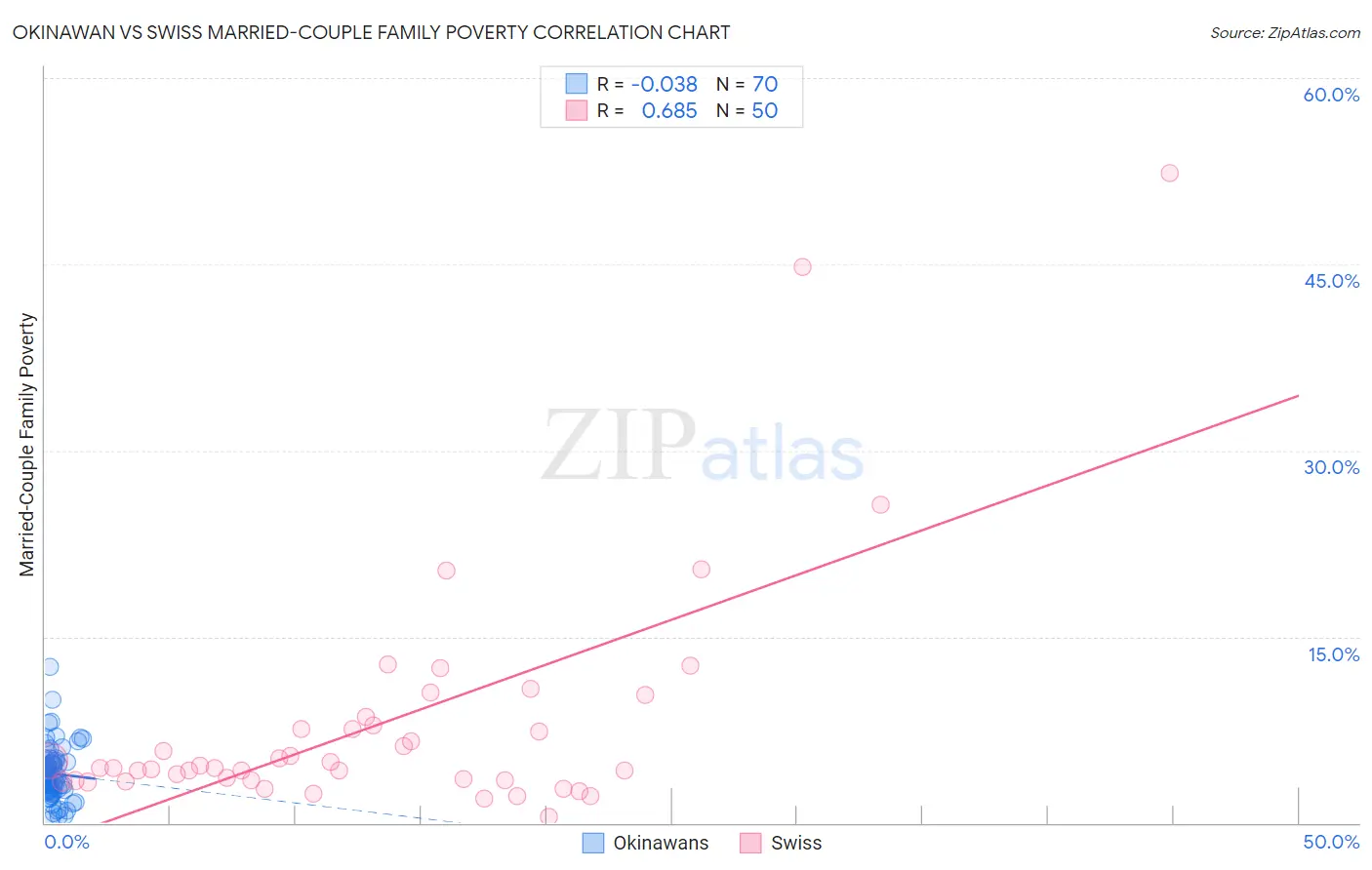Okinawan vs Swiss Married-Couple Family Poverty
COMPARE
Okinawan
Swiss
Married-Couple Family Poverty
Married-Couple Family Poverty Comparison
Okinawans
Swiss
4.4%
MARRIED-COUPLE FAMILY POVERTY
99.6/ 100
METRIC RATING
61st/ 347
METRIC RANK
4.3%
MARRIED-COUPLE FAMILY POVERTY
99.8/ 100
METRIC RATING
43rd/ 347
METRIC RANK
Okinawan vs Swiss Married-Couple Family Poverty Correlation Chart
The statistical analysis conducted on geographies consisting of 73,604,889 people shows no correlation between the proportion of Okinawans and poverty level among married-couple families in the United States with a correlation coefficient (R) of -0.038 and weighted average of 4.4%. Similarly, the statistical analysis conducted on geographies consisting of 457,863,093 people shows a significant positive correlation between the proportion of Swiss and poverty level among married-couple families in the United States with a correlation coefficient (R) of 0.685 and weighted average of 4.3%, a difference of 2.3%.

Married-Couple Family Poverty Correlation Summary
| Measurement | Okinawan | Swiss |
| Minimum | 0.25% | 0.49% |
| Maximum | 12.5% | 52.4% |
| Range | 12.3% | 51.9% |
| Mean | 4.0% | 8.1% |
| Median | 3.7% | 4.4% |
| Interquartile 25% (IQ1) | 2.5% | 3.4% |
| Interquartile 75% (IQ3) | 5.0% | 7.8% |
| Interquartile Range (IQR) | 2.5% | 4.4% |
| Standard Deviation (Sample) | 2.2% | 9.8% |
| Standard Deviation (Population) | 2.2% | 9.7% |
Demographics Similar to Okinawans and Swiss by Married-Couple Family Poverty
In terms of married-couple family poverty, the demographic groups most similar to Okinawans are Immigrants from Australia (4.4%, a difference of 0.010%), Tlingit-Haida (4.4%, a difference of 0.11%), Immigrants from Sweden (4.4%, a difference of 0.18%), Czechoslovakian (4.4%, a difference of 0.73%), and Immigrants from Zimbabwe (4.3%, a difference of 0.82%). Similarly, the demographic groups most similar to Swiss are Immigrants from Japan (4.3%, a difference of 0.38%), Serbian (4.3%, a difference of 0.39%), British (4.3%, a difference of 0.42%), Scottish (4.3%, a difference of 0.44%), and Immigrants from South Central Asia (4.3%, a difference of 0.54%).
| Demographics | Rating | Rank | Married-Couple Family Poverty |
| Scottish | 99.8 /100 | #42 | Exceptional 4.3% |
| Swiss | 99.8 /100 | #43 | Exceptional 4.3% |
| Immigrants | Japan | 99.8 /100 | #44 | Exceptional 4.3% |
| Serbians | 99.8 /100 | #45 | Exceptional 4.3% |
| British | 99.8 /100 | #46 | Exceptional 4.3% |
| Immigrants | South Central Asia | 99.8 /100 | #47 | Exceptional 4.3% |
| Australians | 99.7 /100 | #48 | Exceptional 4.3% |
| Turks | 99.7 /100 | #49 | Exceptional 4.3% |
| Burmese | 99.7 /100 | #50 | Exceptional 4.3% |
| Immigrants | Lithuania | 99.7 /100 | #51 | Exceptional 4.3% |
| Russians | 99.7 /100 | #52 | Exceptional 4.3% |
| Welsh | 99.7 /100 | #53 | Exceptional 4.3% |
| Austrians | 99.7 /100 | #54 | Exceptional 4.3% |
| French | 99.7 /100 | #55 | Exceptional 4.3% |
| Immigrants | Zimbabwe | 99.7 /100 | #56 | Exceptional 4.3% |
| Immigrants | Netherlands | 99.7 /100 | #57 | Exceptional 4.3% |
| Czechoslovakians | 99.7 /100 | #58 | Exceptional 4.4% |
| Immigrants | Sweden | 99.6 /100 | #59 | Exceptional 4.4% |
| Tlingit-Haida | 99.6 /100 | #60 | Exceptional 4.4% |
| Okinawans | 99.6 /100 | #61 | Exceptional 4.4% |
| Immigrants | Australia | 99.6 /100 | #62 | Exceptional 4.4% |